佛跳墙英文介绍(包括做法)ppt课件
- 格式:ppt
- 大小:4.19 MB
- 文档页数:10

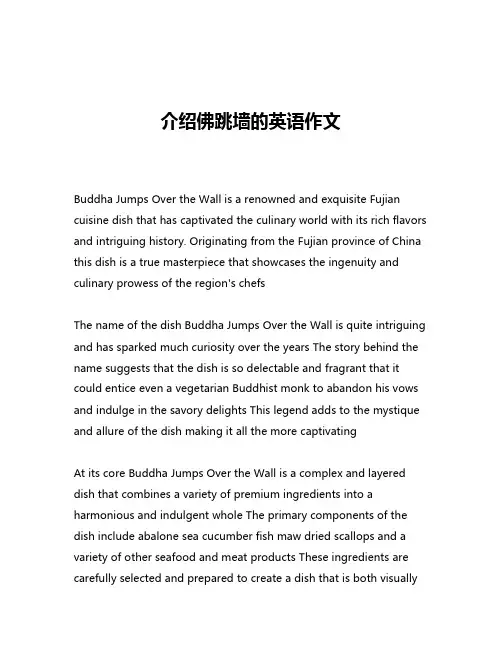
介绍佛跳墙的英语作文Buddha Jumps Over the Wall is a renowned and exquisite Fujian cuisine dish that has captivated the culinary world with its rich flavors and intriguing history. Originating from the Fujian province of China this dish is a true masterpiece that showcases the ingenuity and culinary prowess of the region's chefsThe name of the dish Buddha Jumps Over the Wall is quite intriguing and has sparked much curiosity over the years The story behind the name suggests that the dish is so delectable and fragrant that it could entice even a vegetarian Buddhist monk to abandon his vows and indulge in the savory delights This legend adds to the mystique and allure of the dish making it all the more captivatingAt its core Buddha Jumps Over the Wall is a complex and layered dish that combines a variety of premium ingredients into a harmonious and indulgent whole The primary components of the dish include abalone sea cucumber fish maw dried scallops and a variety of other seafood and meat products These ingredients are carefully selected and prepared to create a dish that is both visuallystunning and gastronomically impressiveThe preparation of Buddha Jumps Over the Wall is a labor-intensive process that requires great skill and attention to detail The seafood and meat ingredients are first cleaned and prepared individually to ensure their freshness and quality They are then carefully arranged in a ceramic pot or casserole dish and slowly simmered for hours to allow the flavors to meld and develop The slow cooking process is crucial to the dish as it allows the ingredients to release their natural juices and oils which then infuse the entire dish with their rich and complex flavorsOne of the key aspects of Buddha Jumps Over the Wall is the use of premium and rare ingredients Many of the components such as abalone and fish maw are considered delicacies in Chinese cuisine and are highly prized for their unique textures and flavors The combination of these luxurious ingredients creates a dish that is not only delicious but also a symbol of wealth and statusIn addition to the premium ingredients the dish is also renowned for its intricate and meticulous preparation techniques The chefs who create Buddha Jumps Over the Wall must have years of experience and a deep understanding of Fujian cuisine to be able to execute the dish to perfection Every step of the process from the initial preparation of the ingredients to the final presentation is carried outwith the utmost care and attention to detailThe end result of this labor-intensive process is a dish that is truly a feast for the senses The aroma of the dish is captivating with notes of savory umami and fragrant spices wafting through the air The appearance of Buddha Jumps Over the Wall is equally impressive with the various ingredients arranged in a visually stunning manner The flavors of the dish are equally remarkable with a perfect balance of sweetness saltiness and richness that lingers on the palate long after the last bite has been savoredBeyond its culinary excellence Buddha Jumps Over the Wall also holds significant cultural significance in Fujian and broader Chinese cuisine The dish is often served at important celebrations and gatherings such as weddings banquets and Chinese New Year festivities It is a dish that is deeply rooted in the culinary traditions of the region and is a source of great pride and cultural identity for the people of FujianIn conclusion Buddha Jumps Over the Wall is a truly remarkable and captivating dish that showcases the ingenuity and culinary prowess of Fujian cuisine The combination of premium ingredients meticulous preparation techniques and rich cultural significance make it a dish that is truly worthy of its legendary status As a testament to its enduring appeal Buddha Jumps Over the Wallcontinues to captivate and delight food lovers around the world who seek to experience the depth and complexity of this culinary masterpiece。
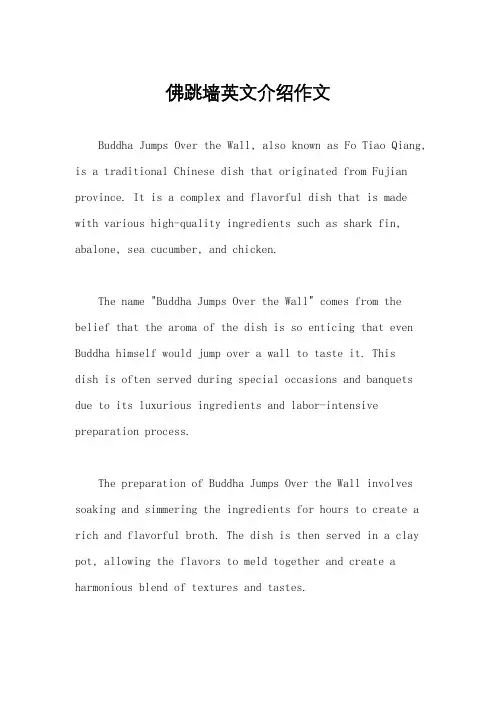
佛跳墙英文介绍作文Buddha Jumps Over the Wall, also known as Fo Tiao Qiang, is a traditional Chinese dish that originated from Fujian province. It is a complex and flavorful dish that is made with various high-quality ingredients such as shark fin, abalone, sea cucumber, and chicken.The name "Buddha Jumps Over the Wall" comes from the belief that the aroma of the dish is so enticing that even Buddha himself would jump over a wall to taste it. Thisdish is often served during special occasions and banquets due to its luxurious ingredients and labor-intensive preparation process.The preparation of Buddha Jumps Over the Wall involves soaking and simmering the ingredients for hours to create a rich and flavorful broth. The dish is then served in a clay pot, allowing the flavors to meld together and create a harmonious blend of textures and tastes.Buddha Jumps Over the Wall is a dish that symbolizes prosperity and abundance in Chinese culture. It is often served as a symbol of good luck and fortune, making it a popular choice for celebrations and important events.The dish has gained popularity not only in China but also in other parts of the world, where it is considered a delicacy and a symbol of Chinese culinary excellence. Its rich history and intricate preparation process make it a dish that is highly regarded and sought after by food enthusiasts everywhere.。
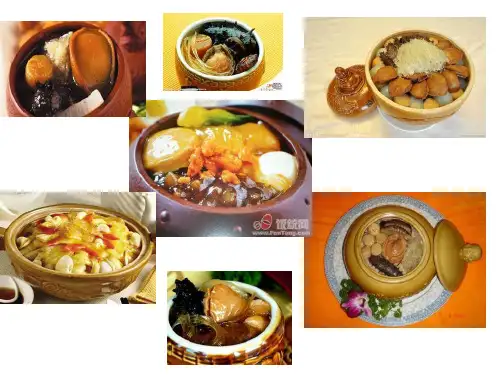
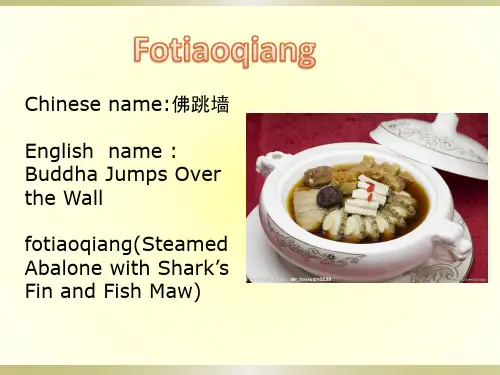

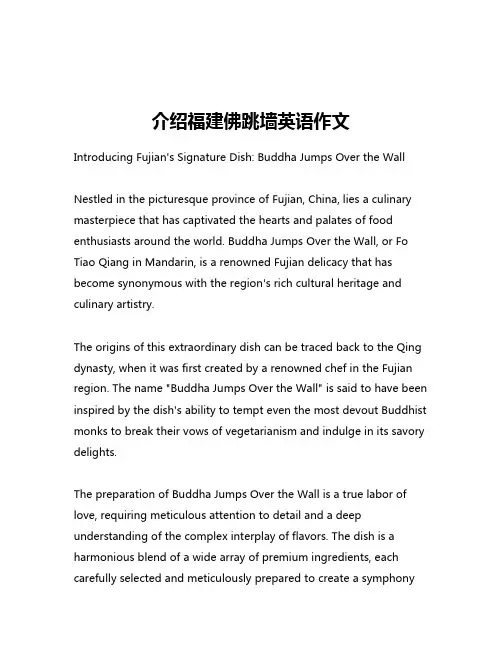
介绍福建佛跳墙英语作文Introducing Fujian's Signature Dish: Buddha Jumps Over the WallNestled in the picturesque province of Fujian, China, lies a culinary masterpiece that has captivated the hearts and palates of food enthusiasts around the world. Buddha Jumps Over the Wall, or Fo Tiao Qiang in Mandarin, is a renowned Fujian delicacy that has become synonymous with the region's rich cultural heritage and culinary artistry.The origins of this extraordinary dish can be traced back to the Qing dynasty, when it was first created by a renowned chef in the Fujian region. The name "Buddha Jumps Over the Wall" is said to have been inspired by the dish's ability to tempt even the most devout Buddhist monks to break their vows of vegetarianism and indulge in its savory delights.The preparation of Buddha Jumps Over the Wall is a true labor of love, requiring meticulous attention to detail and a deep understanding of the complex interplay of flavors. The dish is a harmonious blend of a wide array of premium ingredients, each carefully selected and meticulously prepared to create a symphonyof taste and texture.At the heart of the dish are the finest cuts of abalone, sea cucumber, dried scallops, and a variety of other seafood delicacies. These ingredients are simmered for hours in a rich, savory broth infused with the essence of Chinese herbs, spices, and aromatic vegetables. The result is a luxuriously thick and creamy sauce that coats each morsel of seafood, creating a truly indulgent and memorable dining experience.But the true magic of Buddha Jumps Over the Wall lies in the careful balancing of flavors and the intricate layering of textures. The dish is often described as a culinary journey, with each bite revealing new depths of complexity and nuance. The tender abalone and succulent sea cucumber provide a luscious and velvety mouthfeel, while the dried scallops and other seafood additions offer a delicate crunch and a burst of umami-rich flavor.The preparation of Buddha Jumps Over the Wall is a painstaking process that can take days to complete. The ingredients are carefully selected, cleaned, and prepared in a specific order, with each step designed to enhance the overall flavor and texture of the dish. The broth, for instance, is simmered for hours, allowing the flavors of the herbs and spices to meld and intensify, creating a rich and aromatic base for the other components.One of the most fascinating aspects of Buddha Jumps Over the Wall is the way it has evolved over time, with different regions and chefs putting their own unique spin on the classic recipe. In some versions, the dish is infused with the fragrant aroma of Chinese wine, while others incorporate a touch of sweetness from the addition of dried fruits or candied ginger.Despite these variations, the essence of Buddha Jumps Over the Wall remains the same – a celebration of the bountiful seafood and rich culinary traditions of the Fujian region. The dish is often served as a centerpiece of elaborate banquets and special occasions, where it is revered for its ability to captivate the senses and leave a lasting impression on those who are fortunate enough to experience it.Beyond its gastronomic appeal, Buddha Jumps Over the Wall also holds a deeper significance in Fujian's cultural landscape. The dish is often seen as a symbol of the region's prosperity, creativity, and respect for the natural world. The careful selection and preparation of the ingredients, the intricate cooking techniques, and the reverence for the dish's history all contribute to a sense of pride and identity that is deeply rooted in the Fujian people.In recent years, the popularity of Buddha Jumps Over the Wall has spread far beyond the borders of Fujian, with foodies andgourmands from around the world seeking out this culinary treasure. However, the true essence of the dish can only be fully experienced in the region where it was born, where the flavors are infused with the rich history and vibrant culture of Fujian.As you savor each bite of this extraordinary dish, you can't help but feel a sense of wonder and appreciation for the skill, dedication, and artistry that went into its creation. Buddha Jumps Over the Wall is not just a meal – it is a testament to the enduring power of culinary tradition and the ability of food to transcend cultural boundaries and bring people together in a shared appreciation of the finer things in life.。

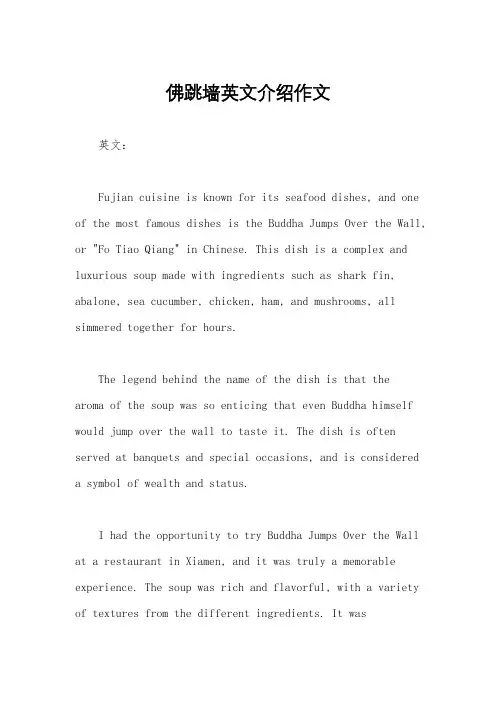
佛跳墙英文介绍作文英文:Fujian cuisine is known for its seafood dishes, and one of the most famous dishes is the Buddha Jumps Over the Wall, or "Fo Tiao Qiang" in Chinese. This dish is a complex and luxurious soup made with ingredients such as shark fin, abalone, sea cucumber, chicken, ham, and mushrooms, all simmered together for hours.The legend behind the name of the dish is that the aroma of the soup was so enticing that even Buddha himself would jump over the wall to taste it. The dish is often served at banquets and special occasions, and is considered a symbol of wealth and status.I had the opportunity to try Buddha Jumps Over the Wall at a restaurant in Xiamen, and it was truly a memorable experience. The soup was rich and flavorful, with a variety of textures from the different ingredients. It wasdefinitely a luxurious and indulgent dish, and I could understand why it was considered a symbol of wealth and status.中文:福建菜以海鲜著名,其中最著名的菜品之一是佛跳墙。

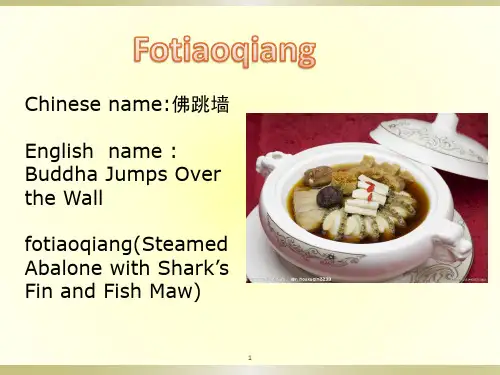
介绍福建佛跳墙英语作文Buddha Jumps Over the Wall is a famous traditional dish originating from Fujian Province in China. It is a culinary masterpiece that showcases the richness and depth of Chinese cuisine. The dish is named after the intriguing story of a monk who was enticed by its aroma and couldn't resist jumping over a wall to enjoy it, despite the religious prohibition.The preparation of this exquisite dish requires an array of premium ingredients and meticulous cooking techniques. It typically includes ingredients such as abalone, sea cucumber, fish maw, scallops, shrimp, chicken, pork, mushrooms, bamboo shoots, and various spices. These ingredients are cooked in a rich broth made with chicken, ham, and superior stock, which is simmered for hours to extract the best flavors.The dish is known for its complex layers of taste and textures. Each ingredient is prepared separately to ensurethat it retains its unique qualities. For example, abalone is braised until tender, sea cucumber is braised until it becomes soft and gelatinous, while fish maw is simmered until it becomes translucent and delicate. These ingredients are then combined and simmered together in the broth to achieve a harmonious blend of flavors.The cooking process of Fukien Buddha Jumps Over the Wall requires both skill and patience. Chefs must carefullycontrol the fire and cooking time, ensuring that the dish is cooked to perfection. The result is a luxurious and flavorful dish that is highly revered in Chinese cuisine.The rich history of this dish can be traced back to the Qing Dynasty. It was originally created for the imperial court, and only the highest-ranking officials could savor its exquisite taste. Over time, the dish gained popularity among the general public and became a must-have in banquets and special occasions.Today, Fukien Buddha Jumps Over the Wall is not only enjoyed in China but also renowned globally. Many Chinese restaurants around the world have added this iconic dish to their menus, attracting food enthusiasts and gourmands alike. Its intricate preparation and unique flavors make it a true masterpiece of Chinese culinary art.In conclusion, Fukien Buddha Jumps Over the Wall is a celebrated dish originating from Fujian Province in China. With its meticulously selected ingredients and complex cooking techniques, it offers a sensory experience that showcases the rich heritage of Chinese cuisine. Whether enjoyed in an extravagant banquet or savored at a local restaurant, this iconic dish continues to captivate the hearts and taste buds of people worldwide.。
Title: The Enchanting Delicacy of Fujian'sFotiaoqiangNestled in the southeastern corner of China, Fujian province is renowned for its rich culinary heritage, with dishes that blend traditional flavors with innovative techniques. Among these culinary treasures, none stands out quite like Fotiaoqiang, a dish whose name translates to "the Buddha jumps over the wall" in English, alluding toits irresistible aroma that is said to be enough to lure even the Buddha from his meditation.Fotiaoqiang is a complex dish that requires meticulous preparation and a diverse array of ingredients. Its origins date back to the Qing Dynasty, when it was first created as a royal delicacy. Over time, it has evolved into a dishthat is both a testament to Fujianese culinary prowess and a symbol of the province's cultural heritage.The preparation of Fotiaoqiang begins with the careful selection of ingredients, which include high-quality seafood, meats, fungi, and spices. Each component is individually processed to enhance its flavor and texture. The seafood, such as abalone, scallops, and shark's fin,are often soaked in wine to infuse them with a rich, mellow taste. The meats, like duck and chicken, are boiled to tender perfection. Fungi and vegetables add a depth of flavor and texture to the dish.Once the ingredients are ready, they are combined in a large earthenware pot and slowly simmered in a broth made from chicken, duck, and pork bones. This slow-cooking process, often lasting for hours, allows the flavors to meld together, creating a rich and complex taste that is both savory and sweet.The final touch is the sealing of the pot, which traps the steam and aroma inside, intensifying the flavors. When the pot is finally opened, the aroma of Fotiaoqiang istruly captivating, with its sweet and savory scent wafting through the air. The dish itself is a visual masterpiece, with its vibrant colors and array of ingredients.In modern times, Fotiaoqiang has become a prized delicacy not only in Fujian but also throughout China and beyond. Its popularity has led to various interpretations and innovations, but the essence of the dish remains thesame - a harmonious blend of flavors and textures that is both satisfying and delightful.Fotiaoqiang is not just a dish; it is a cultural icon that represents the best of Fujianese cuisine. It is a testament to the province's rich culinary history and a testament to the skill and dedication of its chefs. Whether enjoyed as a special occasion dish or as a culinary adventure, Fotiaoqiang is sure to leave a lasting impression on any food lover.**福建佛跳墙的魅力**位于中国东南角的福建省,以其丰富的烹饪传统而闻名,这里的菜肴既融合了传统风味,又不断创新。